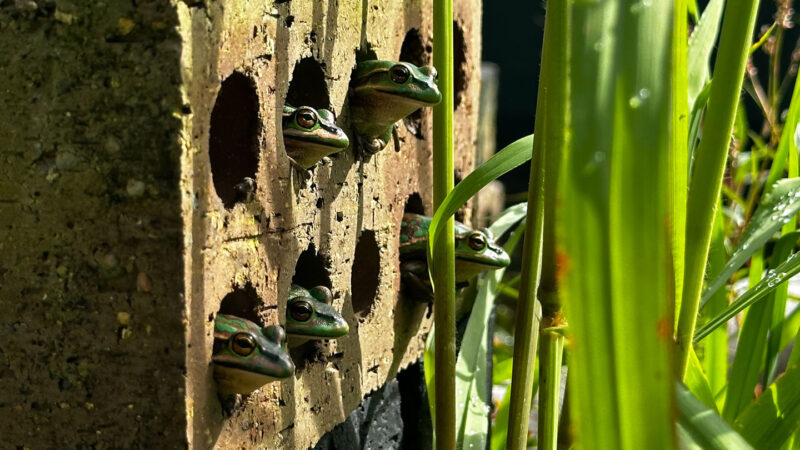Spending a few months in low-cost backyard spas could help frogs fight off a deadly fungal infection. That’s the finding of a new study.
Scientists in Australia placed small brick structures in sunny spots. Later, green and golden bell frogs infected with chytrid (KIH-trid) fungus took shelter in these cubbies. In little time, the frogs warmed up enough to fight off that fungal pathogen. Anthony W. Waddle and his team report their findings in the July 11 Nature.
The chytrid fungus (Batrachochytrium dendrobatidis) invades the thin skin of amphibians. Once established, a chytrid infection blocks the flow of electrolytes, other fluids and oxygen into and through the body. That can disrupt the animal’s ability to move and feed itself. These effects can be fatal.
These infections have been linked to population declines in at least 500 amphibian species across the globe. Hit especially hard is the Australian green and golden bell frog (Litoria aurea). This species can no longer be found in 90 percent of areas it used to call home.
Saunas for frogs
Chytrid is known to thrive at relatively cool temperatures. In the lab, it can’t grow and reproduce above 30° Celsius (86° Fahrenheit). A bell frog’s optimal temperature is around 29 °C (84 °F) — one that’s not ideal for chytrid. But in winter, when air temperatures drop, chytrid infection rates spike in these frogs.
Waddle is part of a team that wanted to test whether warm hideouts could help frogs fight off the fungus. A conservation biologist, Waddle works at Macquarie University in Australia. The team set up 12 outdoor habitats for the frogs. Each one included water, artificial plants and shelters made of black masonry bricks. The bricks were enclosed in little greenhouses.
The team placed healthy frogs in four of the habitats. In the other eight, they introduced a mix of healthy frogs and ones infected with chytrid. Cloth shaded half of the shelters. The other half received sunlight, to ensure a range of balmy temperatures.
All frogs took to the shelters right away. Outside temperatures around 20 to 25 °C (68 to 77 °F) gave frogs in the unshaded bricks an additional 15 to 20 degrees C of sauna-like warmth. Shaded shelters were an average of 4.5 degrees C cooler than the unshaded ones.
During the 15-week study, frogs that had access to sun-warmed “saunas” kept higher body temperatures than those that accessed the shaded ones. They also had milder infections. But shaded or unshaded, both types of shelters helped infected frogs keep disease in check. In the end, they survived at a rate similar to that of healthy frogs.
Some frogs with chytrid cleared their infections. Afterward, those frogs were better able to fend off the fungus. They were 23 times as likely to survive reinfection as frogs that had never had chytrid, the team found.
These mini saunas could help bell frogs and other hard-hit species develop resistance to chytrid, the researchers conclude.
Good for one species, good for another?
Bell frogs are well-adapted to urban living. Before the chytrid fungus arrived, they “used to live in people’s toilets and letterboxes and everywhere,” Waddle says. “Setting up these habitats where they still persist might give them enough of a boost that you could see a population increase.”
The shelters are easy to build and low-cost, so people could put them in their own gardens, says Erin Sauer. She’s a disease ecologist at the University of Arkansas in Fayetteville.
But hold off installing that backyard frog spa for now. It’s not certain that every species will benefit, says Pennsylvania biologist Cori Richards-Zawacki. She specializes in amphibians at the University of Pittsburgh. For instance, there’s the Panamanian golden frog (Atelopus zeteki). Chytrid has also hit it hard. But these frogs prefer cooler sites. It’s possible, she says, that they might be even more susceptible to chytrid at higher temperatures.
“Chytrid is a huge, massive problem,” Waddle says. The study may not offer a solution for all species, he adds — “but it is a glimmer of hope.”




